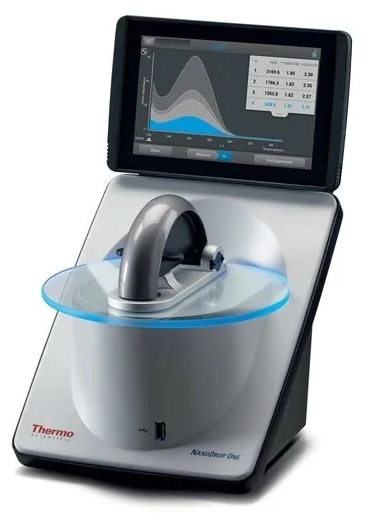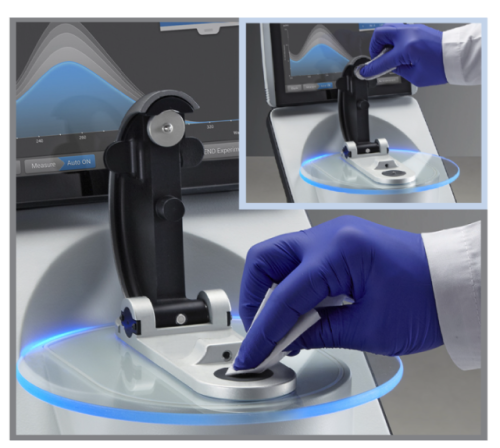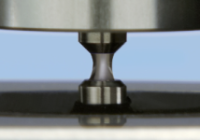Spectrophotometer
- Update Date:2025-04-15
- Units:Instrumentation Resource Center
[YangMing] NanoDrop Spectrophotometer - Thermo ND One

- NanoDrop One Spectrophotometer
- Model: Thermo Scientific / ND one
- Location: Yang-Ming Campus
- Room 615, 6th Floor, Library, Information & Research Building (Machine G)
- Room B02, B1 Floor, Shou-ren Building (Machine H)
- Term of use: Available anytime
- Free of charge on campus, please contact the center staff for off-campus services.
- Only nucleic acid samples, no proteins!
- Contact us:
- Extension: 62382
- E-mail: ycirc@nycu.edu.tw
The principle of NanoDrop One is to utilize the surface tension property of liquid; only a 1.0~2.0ul sample is needed for measurement. The contact between the upper and lower arms pulls the liquid column out on the micro-carrier (pedestal). The instrument has five optical path lengths (1mm~0.03mm) and will automatically adjust while detecting. Then, the absorbance value and sample concentration are obtained after extrapolating the calculation according to Beer's Law. The process takes only 3-8 seconds. There is no need for consumables (e.g., quartz cuvettes, capillary tubes, or microplates). This patented design is famous worldwide for its accuracy and convenience, allowing scientists to conduct their research more efficiently.
- The ND one utilizes a xenon flash lamp to provide complete spectrum detection from 190 to 850 nm and is ready to use without warming up. With the high-sensitivity CCD array detector, the absorption value can be as high as 550 Abs (dsDNA concentration 2~27,500ng/ul), and most of the purified nucleic acids can be detected without dilution.
- The homogeneity of the samples to be tested is the highest requirement of ND one. Generally, samples should be homogenized by a vortex mixer or pipetting several times before detection. To avoid genomic DNA samples breaking due to the above action, you can heat the sample at 55゚C for about one minute to homogenize before detection.
- Note: Only nucleic acid samples can be used! No protein samples!
- Different detection modes:
- Nucleic Acid: Absorption spectrum, 230nm, 260nm, 280nm absorption values (converted to 10mm aperture absorption values), 260/280 ratio, 260/230 ratio, and nucleic acid concentration.
- UV-Vis: Absorption values and spectra for all wavelengths between 190 and 850nm (presented as 1mm path length absorptions).
| Sample Type | Minimum Concentration | Maximun Concentration | Reproducibility (more than five repetitions) |
|---|---|---|---|
| Nucleic Acid | 2 ng/μL | 27,500 ng/μL (dsDNA) 22,000 ng/μL (RNA) 495 ng/μL (ssDNA) |
|
| Pure BSA | 0.06 mg/mL | 825 mg/mL |
|
| IgG | 0.03 mg/mL | 402 mg/mL |
|
Note: Only nucleic acid samples can be used! No protein samples!
- This machine is available for use at any time.
- After sample detection, please use the Kimwipe to wipe the pedestal and then use clean RO water to check the background value. The background value must be within ±0.04. Otherwise, it must be cleaned again and re-read until it is within the range to be considered as the end of the cleaning. Write down the ratio of A260 and A280 in the registration book.
** Protein measurement is strictly prohibited! **
- Wipe the pedestal with a Kimwipe immediately after detection. First, take a piece of Kimwipe to absorb the liquid from the upper and lower pedestals, then fold this wipe back to the inside and fold it four times. Wipe the pedestal in one direction several times (5 times for DNA), and vigorously push with your fingertips to ensure it is cleaned thoroughly. Both the upper and lower pedestals should be cleaned.
- One drop of the same fluid can only be used once for detection. If you want to repeat measurements of the same sample, please wipe off the previous drop and replace it with a new one.
- Basically, 1~2ul of the nucleic acid sample can be measured. The volume requirement may vary according to the characteristics of each liquid volume. In principle, it should not be more than 2ul. Please use the 2ul pipette to avoid insufficient volume, which may lead to the failure of the complete formation of the liquid column.
- Whenever the software pops up an error message, please read it carefully and follow the instructions to troubleshoot. The most common situation is that the liquid column must be formed correctly during detection. Observe with your naked eyes to check whether the liquid column is connected to the pedestals or if bubbles are in the sample. Pull up the upper arm, wipe off the drop, and repeat the detection, increasing the sample volume to 2ul if necessary.
- The correct liquid column should be like:
- Do not use samples containing Hydrofluoric Acid (HF); only non-corrosive solutions can be used.
- Appearance check: Check the appearance of the instrument for damage.
- Instrument cleaning: Use lab wipe paper to clean the dust left on the instrument.
- Measurement pedestal Cleaning: Add 3-5μL of clean deionized water on the pedestals, gently lower the upper arm so that the upper and lower pedestals can be immersed in clean deionized water, and let it stand for about 2-3 minutes. Then, wipe off deionized water with clean Kimwipe paper to complete the cleaning step. (User manual p.208)
- Confirm the cleanliness of the pedestals: Choose the Nucleic Acid detection mode, blank with clean deionized water, wipe it off, and then use clean deionized water for detection. Verify that the values of A260 and A280 are both within ±0.04 (10 mm path). If so, pedestal cleaning is complete; repeat the cleaning and detection procedure described above if the values are outside this range.
Related Image(s):












 中文
中文





